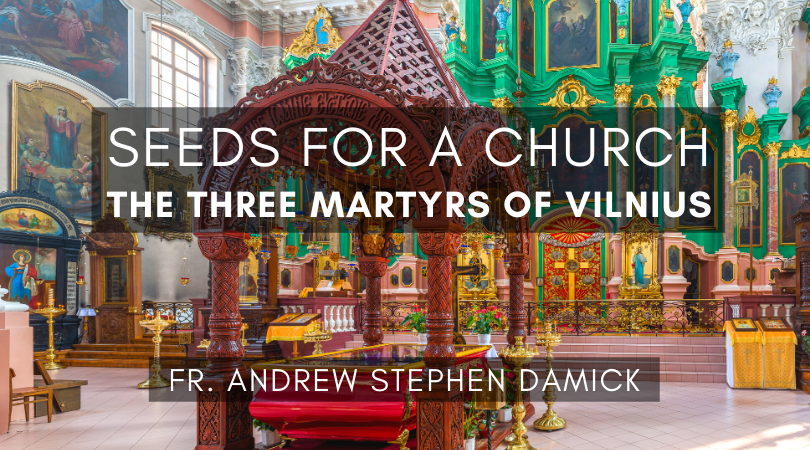
I have over the past several years become more interested in the heritage from my paternal line, represented by my great-grandparents who immigrated to the United States from Lithuania (then part of the Russian Empire) early in the twentieth century. As far as I can tell, nothing of the culture or language has been preserved in my family here.
I only just recently figured out what town my great-grandfather Antanas (Anthony) was from. I have only a vague idea of where his wife Olga was from. They did not immigrate together but rather met and married in this country.
In case you are wondering how Damick could possibly be a Lithuanian name, well, it’s a bit mangled from the Domeika that it used to be. My great-grandfather thought Antanas Domeika didn’t fit in too well in America, so Anthony Damick he became. I’m told that Domeika ultimately comes from Lithuanian domėtis, which refers to interest, concern, care, wonder or curiosity. So I sometimes tell people that wonder and curiosity is baked into my genes, even if we lost our conscious knowledge of the recipe some generations back.
As a Third Culture Kid, the question of where and how I belong is always present with me, and it can never quite be answered. And having an ethnic heritage that was not actually passed down to me as an inheritance seems like another exercise in that odd, defamiliarized life that TCKs can never quite escape. And what’s more, being an Orthodox Christian has in many ways felt like an exercise in the same narrative. A people who were not my own have become my people.
But my problem is that I don’t really have a people who are my own. To put it in the modern cynical parlance of our times, every connection I make is an act of cultural appropriation.
But I am not cynical about cultural acquisition. In fact, I regard it as basically what human beings are made for, and I also believe that opening ourselves up to acquire new cultural elements is an act of humility and grace, and if it’s done with love and care, it is not appropriation in any negative sense but rather incorporation and growth.
An Orthodox Discovery of Lithuanian Christianity
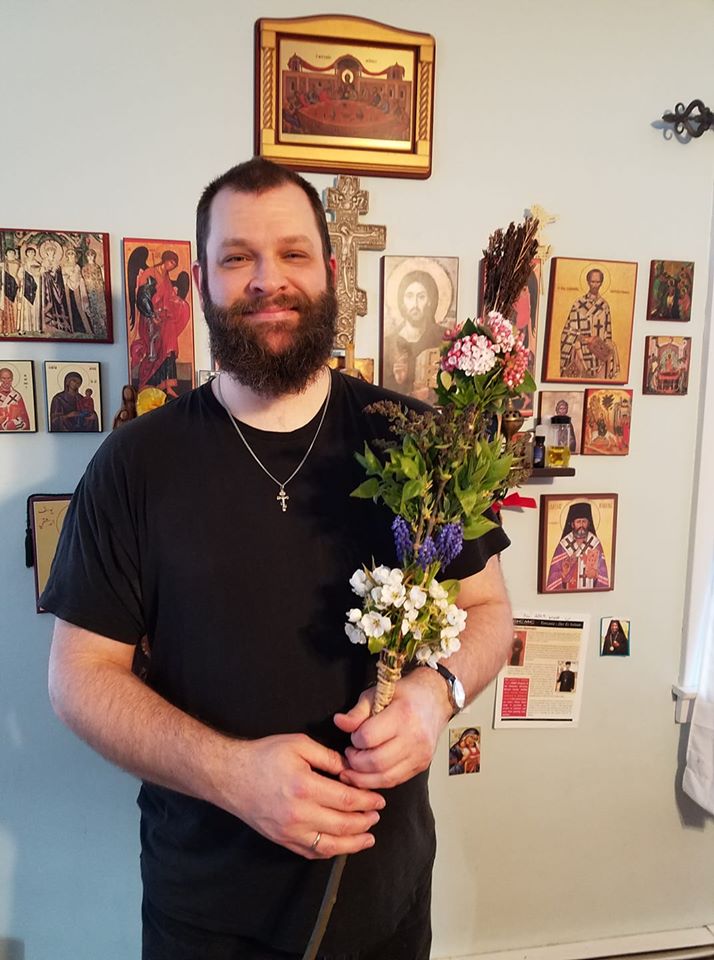
As part of my incorporation of Lithuanian culture (at least as much as I am able), I recently made a verba to use on Palm Sunday. It worked pretty well, though it was a little wilty on the actual day itself.
These are carried by Lithuanians on Palm Sunday instead of actual palm leaves, mainly because palm trees don’t grow anywhere near there. I have read that Polish Christians make and carry these, as well. There is even an amusing ritual of sorts done with them: Lithuanian children especially will hit each other with their verbos, saying ne aš mušu, verba muša, which means, “I’m not hitting you; the verba is hitting you.”
Though I very much admire their beauty, I have not yet tried my hand at making margučiai, which are Lithuanian Easter eggs. They are made either with an etching technique or sometimes with the wax technique known to Ukrainian pysanky makers. I have recently learned that there is also an older technique involving wrapping plants around the eggs and then dyeing them. I may try scratching at a few of my wife’s red eggs this year. I’m not exactly a very artistically inclined person, though.
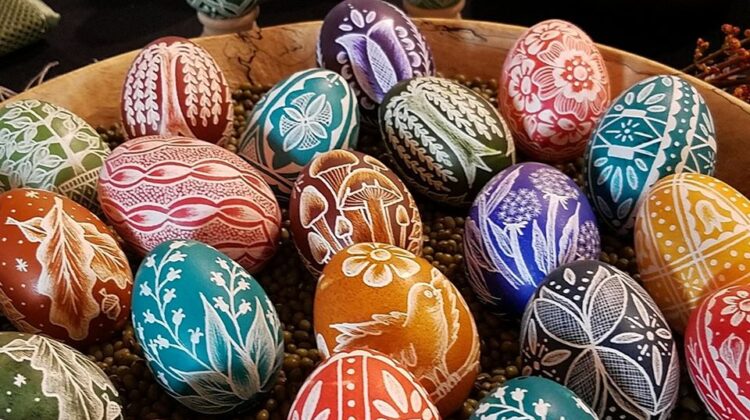
It’s these Christian elements of Lithuanian culture that interest me the most. Since I was not raised with it, I will never “be” Lithuanian in the sense of truly being part of that culture, but I have found some things to love that I can incorporate even as one who is connected by history but not by lifelong participation.
The last pagan nation in Europe to convert to Christianity, most Lithuanians now are Roman Catholic by baptism, but what is less known is that Orthodox Christianity has been present in the country since at least AD 1318, with the marriage of Maria of Vitebsk to the (then-future) Lithuanian Grand Duke Algirdas. He seems to have converted himself but later reverted to the worship of Perkunas, the Baltic thunder and lightning god, after the death of Maria (ca. 1346).
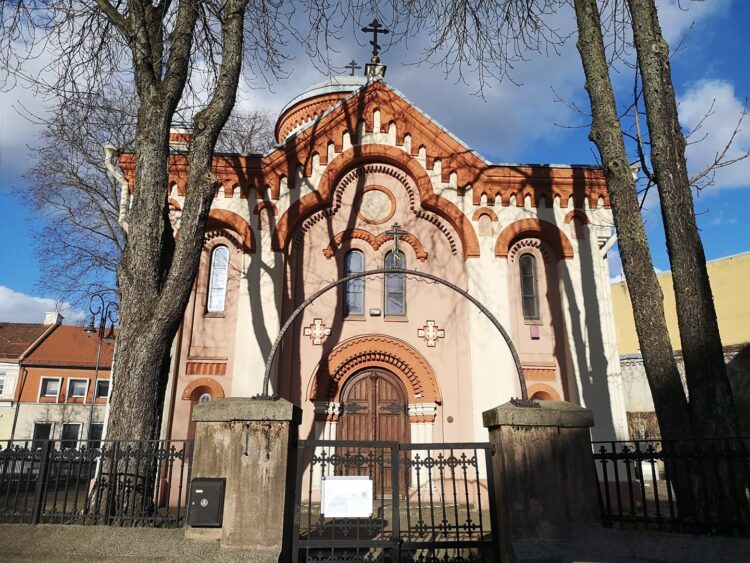
During those nearly three decades of their marriage, she not only bore him many children but also introduced Orthodox Christianity to Lithuania. She had a church built on the location of a former temple to Ragutis, the Baltic god of beer and brewing, and the parish still exists as the Church of St. Paraskevi in Vilnius, the capital of the country. It is one of two churches in the world where Orthodox worship is conducted fully in the Lithuanian language.
There are about fifty Orthodox parishes in Lithuania, belonging to the Archdiocese of Vilnius and Lithuania of the Russian Orthodox Church, and most worship in Church Slavonic. None other than St. Tikhon of Moscow, Enlightener of North America, was once the archbishop of that see, governing it briefly from 1914 to 1917. He was the Archbishop of Vilnius when he was elected in 1917 as the first Patriarch of Moscow in the modern era. Many are not aware of this piece of his history, as the see is often listed as “Vilna” in many English-language texts, which are simply transliterating the Russian name for the city.
Most Orthodox Christians in Lithuania are of Russian descent, along with some Belarusians and Ukrainians and others, and as is the case for many here in America, the faith is seen by most locals as an ethnically-oriented faith. (I have a Lithuanian friend who, when he converted to Orthodox Christianity, was asked by his mother why he would do such a thing, since he is not Russian.) Nonetheless, it appears that with the founding of St. Paraskevi Church, Christianity came to Lithuania, and it was Orthodox Christianity, not Roman Catholicism, that was first. And with 700 years of Orthodox presence in Lithuania, there is certainly broad foundation for regarding Orthodox Christianity as authentically Lithuanian.
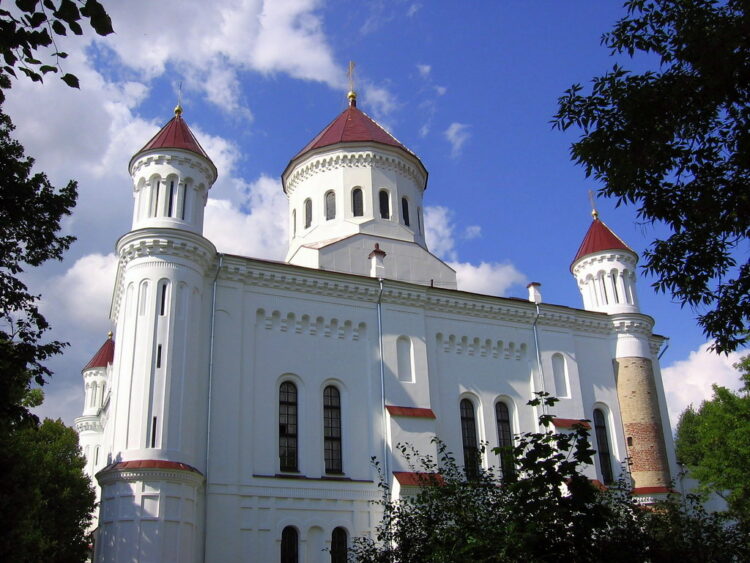
Once I began posting on social media about my Lithuanian connection, I was contacted by Orthodox Christians in Lithuania, a number of whom are converts. And I was told that there is now a race of sorts on to translate liturgical texts into Lithuanian, not just for use in the Church of St. Paraskevi but elsewhere. Many ethnically Slavic Orthodox Christians are marrying native Lithuanians, and their children aren’t as comfortable with Slavonic in church, many of whom don’t speak the Slavic language of their immigrant parents and grandparents. This is a story that we Orthodox Christians in America are also living right now, though we are further along in the process of indigenization.
Seeds for a Church, Seeds for a Christian
An ancient saying from the Church is attributed to the early Christian writer Tertullian: “The blood of the martyrs is the seed of the Church.” So I want to close this brief appreciation for Orthodox Christianity in Lithuania by mentioning the three martyrs whose blood was planted in the ground in those first years of Christianity’s presence in the country — Ss. Anthony (Antanas), John (Jonas) and Eustathius (Eustachijus).
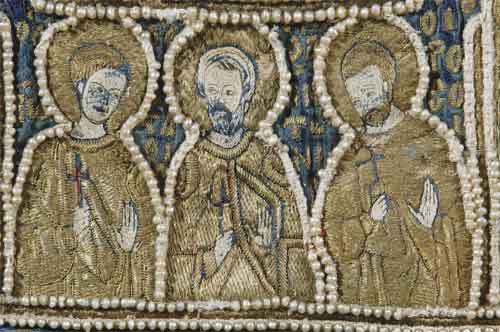
Their feast day is April 14 (which is the day I’m writing this). They converted to Christ during the marriage of Maria of Vitebsk to Algirdas, having formerly been pagans. And after Algirdas reverted to paganism, their own Grand Duke had them martyred when they refused to partake of sacrifices to his idol Perkunas. They suffered for Christ in 1347.
I have recently commissioned an icon of these three saints from Protodeacon Paul Drozdowski, who himself loves and venerates these martyrs. My hope is to bring it with me someday on a pilgrimage to their holy relics. Their reliquary at the Orthodox Monastery of the Holy Spirit is the featured image for this post and also is the primary banner for my blog.
After their martyrdom, their story made its way to the great Russian ascetic St. Sergius of Radonezh, who requested portions of their relics for his own veneration. So their story is part of the life of one of the greatest of Russian saints, and their seed was therefore planted in the Russian church, as well.
I have learned that being Christian is very much bound up in relationships. And relationships are the place where true cultural incorporation happens. I might learn a handicraft or two on my own, but it’s people who are the key to connection and to living in Christ. And these three holy men who said “yes” to Christ even when it meant giving up their lives are my most beloved connection to the Orthodox Christianity of the country of my great-grandparents.
The Life of the Three Martyrs of Vilnius
The following is their martyrdom story along with an icon of them:
The Holy Martyrs Anthony, John, and Eustathius (Kumetis, Nežilas, and Krulis) were brothers who suffered for Christ under the Lithuanian Great Prince Algirdas (1345-1377). The prince was married to the Orthodox princess Maria Yaroslavna (+ 1346). He was baptized and during his wife’s lifetime he allowed the preaching of Christianity. Two brothers, Nežilas and Kumetis (Nezhilo and Kumets), received holy Baptism from the priest Nestor, and they received the names Anthony and John. And at the request of Maria Yaroslavna an Orthodox church was built at Vilnius (Vilna).
After the death of his spouse, Prince Algirdas began to support the pagan priests of the fire-worshippers, who started a persecution against Christians. Saints John and Anthony endeavored not to flaunt their Christianity, but they did not observe pagan customs. They did not cut their hair as the pagans did, and on fast days they did not eat forbidden foods.
The prince soon became suspicious of the brothers, so he interrogated them and they confessed themselves Christians. Then he demanded that they eat meat (it was a fast day). The holy brothers refused, and the prince locked them up in prison. The brothers spent an entire year behind bars. John took fright at the impending tortures and declared that he would obey all the demands of the Great Prince. The delighted Algirdas released the brothers and brought them to himself.
But Anthony did not betray Christ. When he refused to eat meat on a fast day, the prince again locked him up in prison and subjected him to brutal tortures. The other brother remained free, but both Christians and pagans regarded him as a traitor and would not associate with him.
Repenting of his sin, John went to the priest Nestor and entreated him to ask his brother to forgive him. “When he openly confesses Christ, we will be reconciled,” Anthony replied. Once, while serving the prince at the bath, Saint John spoke privately with him about his reconciliation with the Church. Algirdas did not display any anger and said that he could believe in Christ, but must conduct himself like all the pagans. Then Saint John confessed himself a Christian in the presence of numerous courtiers. They beat him fiercely with rods and sent him to his brother in prison. The martyrs met with joy, and received the Holy Mysteries that same day.
Many people went to the prison to see the new confessor. The brothers converted many to Christ by their preaching. The prison was transformed into a Christian school. The frightened pagan priests demanded the execution of the brothers, but they did not fear death.
On the morning of April 14, 1347 the Martyr Anthony was hanged on a tree after receiving the Holy Mysteries. This oak, which the pagans considered sacred, became truly sacred for Orthodox Christians.
The pagan priests who hoped that Christian preaching would stop with the death of Saint Anthony, were disappointed. A multitude of the people gathered before the walls of the prison where Saint John was being held. On April 24, 1347 they strangled him and hanged his dead body upon the same oak. The venerable bodies of both martyrs were buried by Christians in the church of Saint Nicholas the Wonderworker.
A third sufferer for Christ was their relative Krulis (Kruglets). At Baptism the priest Nestor named him Eustathius. Krulis stood out because of his comeliness, valor and bravery, but even more because of his mind and virtue of soul. A favorite of Algirdas, he could count on a very promising future. However, he also refused to eat meat at the festal table. Saint Eustathius openly declared that he was a Christian and would not eat meat because of the Nativity Fast.
They began to beat him with iron rods, but the youth did not make a sound. The prince tried refining the torture. Algirdas gave orders to strip the martyr naked, take him out on the street and to pour icy water in his mouth. But this did not break his spirit. Then they broke his ankle bones, and ripped the hair and skin from his head, and cut off his ears and nose. Saint Eustathius endured the torments with such gladness and courage, that the very torturers themselves were astounded by the divine power which strengthened him. The martyr Eustathius was sentenced to death and hanged on the same oak where Saints John and Anthony received a martyr’s death (December 13, 1347).
For three days no one was permitted to take down the body of the martyr, and a column of cloud protected it from birds and beasts of prey. A church was later built on the hill where the holy martyrs suffered. The trinity of venerable passion bearers glorified the true God worshiped in the Holy Trinity, Father and Son and Holy Spirit. The church was dedicated to the Most Holy Trinity. The altar table was built on the stump of the sacred oak on which the martyrs died.
Soon their relics were found to be incorrupt. In 1364 Patriarch Philotheus of Constantinople (1354-1355, 1364-1376) sent a cross with the relics of the holy martyrs to Saint Sergius of Radonezh (September 25). The Church established the celebration of all three martyrs on April 14.
The holy martyrs were of immense significance for all the Western frontier. Vilnius’s monastery of the Holy Trinity, where the holy relics are kept, became a stronghold of Orthodoxy on this frontier. In 1915 during the invasion of the Germans, these relics were taken to Moscow.
The relics of the holy passion-bearers were returned to the Vilnius Holy Spirit monastery in 1946. The commemoration of their return (July 13) is solemnly observed at the monastery each year.
Text included by permission from OCA.org.
![]()
Hymns to the Martyrs from the Menaion
Following are a few of the primary hymns to the Three Martyrs of Vilnius taken from the Menaion:
Apolytikion for the Martyrs (Tone 4): O valiant and honored athletes who spurned earthly honors and glory, mightily and manfully did ye endure torments for the sake of the Faith, giving yourselves over to death for the Master, the Life of all. Wherefore, with a pillar of cloud from heaven did Christ all-gloriously illumine you. Standing before Him with the angels, pray ye that our souls be saved.
Another Apolytikion for the Martyrs (Tone 4): Having caused branches of the Orthodox Faith to spring forth from a barren root, O all-blessed ones, ye were shown to be namesakes of the protomartyr; for ye were not daunted by the wrath of the evil and impious prince, who commanded you to renounce Christ. Wherefore, having received crowns of victory, and standing with the angels before the throne of the Master, O all-blessed ones, pray for us who in Orthodox manner honor your holy memory.
Kontakion for the Martyrs (Tone 3, “The Virgin cometh today”): Having forsaken the deception of your fathers, O holy ones, ye cleaved unto Christ, and with ardor of soul ye stood firmly unto death with manly mind. Wherefore, ye have truly taken in hand the trophy of victory, unceasingly entreating our Master for us all.
Through the prayers of the holy martyrs Antanas, Jonas and Eustachijus, Lord Jesus Christ our God have mercy on us and save us!




Thanks very much for this post. I have Lithuanian roots, and was raised in a Lith. RC church. A relative was the RC bishop of Vilnius from 1918 till about 1925. Might have known St Tikhon.
I live on the other side of the Blue Mtn from you. My bro lives in Trexlertown. Hope to visit your parish someday. Especially if there’s homemade baba ganoosh at coffee hour!
You’ll be welcome! As to whether there’s baba ghanoush, it depends on who has coffee hour that week. 🙂
I remember my Mom whacking my Dad w/ palms (he stayed home) and saying something in Lithuanian. Now I finally know! Thanks boatloads for that!
How very interesting, Father! If you make a pilgrimage to Lithuania, and are willing to take a group of people with you to venerate their relics, I would be interested in going with you, if possible.